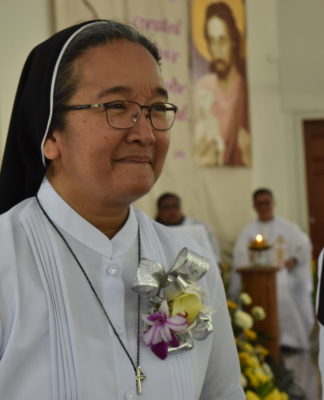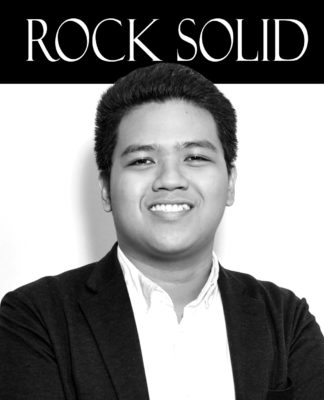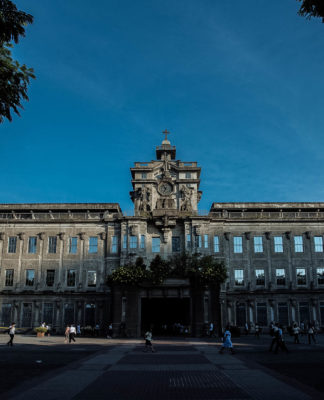AFTER four centuries, UST remains “timeless and forever timely.”
Drawing parallels between the celebrations of 1911 and 2011, the Rector showed how history repeated itself in the Quadricentennial and Neo-Centennial festivities as he delivered his “end-term” report at the Quadricentennial Pavilion last March 19.
Fr. Rolando de la Rosa, O.P., who recently ended his third term as rector of Asia’s oldest university, noted that the centerpiece project of the Quadricentennial celebration, “Simbahayan,” was similar to the project initiated by Thomasians for the UST tricentennial in 1911.
“They saw in the tercentenary celebration an opportunity to help the poor so they staged a comic play titled ‘El Hijo de la Nieve’ at the [old] Manila Opera House on Dec. 3, 1911 for the purpose of raising funds to be spent during the feast for the poor,” the Rector said.
Simbahayan, meanwhile, accomplished 862 community development projects. The National Service Training Program was the highest contributor with 121 projects, De la Rosa said. The project took shape in 2009 when the Rector urged Thomasians to build and help communities across the country.
The cultural and social significance of the Quadricentennial—which was covered by broadsheets, magazines, and other media in the Philippines and other countries—was also a repeat of the recognition received by UST when it celebrated its 300th year in 1911, he said.
“During the third centenary, one journalist wrote in the Manila Times declaring the University of Santo Tomas ‘inexhaustible, a center of splendid culture, the first [in the] orient,’” De la Rosa said.
A century ago, a grand parade of Thomasians and students from other schools in Manila was one of the highlights of the tricentennial festivities. UST also staged a “Quadricentennial Parade” in January last year.
In 1911, only one memorabilia, a commemorative plate, was released. In 2011, the commemorative items included Swatch watches, stamps that portrayed cultural treasures of the University, 200-peso bills with the ‘Q’ logo, and commemorative medals.
The high regard for the University as a praying community was highlighted in both the tricentennial and the Quadricentennial celebrations, the Rector said. He cited the homily of Lingayen-Dagupan Archbishop Socrates Villegas in January’s “Neo-Centennial” Mass and compliments given in 1911 by Bishop Dennis Joseph Dougherty of the Diocese of Jaro.
“Whether in 1911 or 2011, Thomasians have always been considered as unique, classic, timeless, and forever timely, so we present-day Thomasians, must also affirm this quality within us,” he said.
Like in previous Rector’s reports, De la Rosa commended UST’s sterling performance in various licensure examinations since 2008.
There were 28 topnotchers each in the Architecture and Medical Technology board exams; 26 in Pharmacy; 25 each in Medicine and Interior Design; 23 in Occupational Therapy; 20 in Physical Therapy; 15 in Nutrition and Dietetics; 13 in Secondary Education; 12 each in Civil Engineering and Industrial Engineering; five in Chemical Engineering; four each in Mechanical Engineering, Chemistry, and Library Science; and two in Electronics Engineering.
Meanwhile, De la Rosa pointed out that one of the weaknesses of the University’s faculty members is their failure to live up to the “publish or perish” rule, which is strictly observed in many universities abroad.
“Very few of our faculty members publish anything,” De la Rosa said. “In fact, I deplore the lack of initiative among our faculty to write commentaries in newspapers that often unfairly criticize the University.”
He added that very few faculty members write “about the good things that they experience in the University.”
De la Rosa resigned last March 31, ending his third term a month in advance to hasten the selection process for the next rector. De la Rosa is still eligible for another term.
A former Witness (religion section) editor of the Varsitarian, he took over the rectorship in 2007 following an intra-order dispute over the redevelopment of UST Hospital.
He had served as rector for two terms from 1990 to 1998, before becoming rector of the Colegio de San Juan de Letran-Calamba in 2003 and chairman of the Commission on Higher Education from 2004 to 2005. R. L. Antonio, R. D. Madrid, and B. D. Nicolas


















